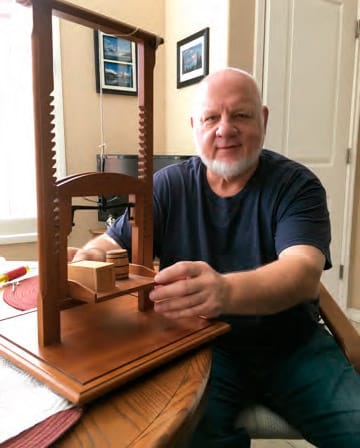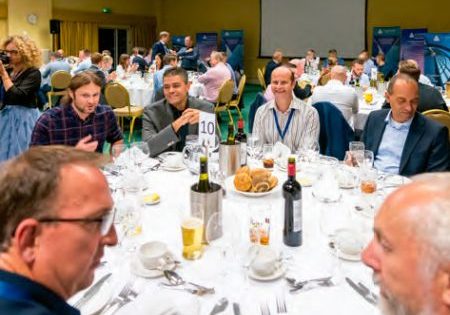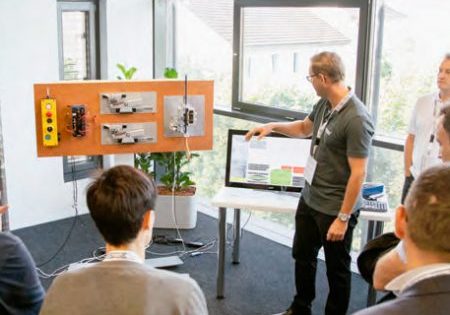10 Questions With Bob Shepherd
Dec 1, 2019

The eternal optimist speaks on changes in and the future of NAESA and much more.
by Lee Freeland
Executive director of NAESA International and longtime elevator man Robert “Bob” Shepherd (RS) had the chance to catch up with ELEVATOR WORLD (EW) around the time of the Wisconsin Elevator Symposium in September (p.126). Here, he updates us from his last interview (EW), May 2016) and talks about NAESA, the QEI program, the recent residential elevator safety issue and more.
EW: We know you got started as a probationary International Union of Elevator Constructors (IUEC) helper in 1973 in Philadelphia, but what got you started in the industry, and what made you stay?
RS: I had left Kutztown State college in the Pennsylvania Dutch country to get married with an expectation of returning to college to gain my degree in elementary education. Then, life got in the way. Once married, I tried to attend school at night to finish, but dire financial needs caused a major distraction, and a job was needed. I took a job for a short time with the Philadelphia Housing Authority and worked for a time with the riggers out of the Iron Workers Union in Philadelphia. Then, the break came.
My father, who worked for Eastern Elevator Co. in Philadelphia, asked me if I was interested in working in the elevator industry, installing and working on elevators out of IUEC Local No. 5. My first question was, “How much does it pay?” because, at the time, I was making US$9.25 per hour as a rigger, which was great money in 1972. My dad told me my starting pay would be $4.62 per hour, so I was very hesitant to leave my rigging job for half the money. I spent a day considering my options and decided a career in the elevator industry would be much better,
long-term, than keeping a job where my physical strength was always drained, and my brain never seemed challenged. Turns out, it was one of the best decisions I have ever made. So, now, many years later, my dad is gone, and Eastern Elevator is gone, as are most of the people I knew there. My first paycheck was US$88.00 net, and I had a mortgage on my home of US$49.50 per month for a small house in Philly. This US$49.50 included real estate taxes and homeowners insurance, and I was concerned I could not pay my bills. In six months, when I got a raise in pay to US$6.48 per hour, I figured I was now rich and had some wiggle room for my bills. So: job security, bills to pay, steady work and the uniqueness of the elevator industry guided me to making the right decision.
I have to be honest: I stayed in the industry at first for the money and benefits, but then, the elevator industry became a part of my heart and soul. I was proud to show off and wear a hard hat and safety belt as I helped build America, and that was only the beginning. I was even prouder that I was working in an industry where you did it all and became skilled at doing so. I worked hard, showed up every day, kept my mouth shut (back then) and listened and learned daily — and I never stopped learning. In the span of my career, I went from car-switch elevators and relay-logic controllers with big, inefficient AC machines where everything was heavy, dirty and massive, to destination dispatching, microprocessor controls with permanent-magnet motors and solid-state drives with cartop sheaves and deflectors you can carry in one hand and so much more.
Times have really changed, and I am glad I have been a part of it all, from the good old days of the industry to now, where it all moves so quickly, from the speed of elevators, to the ever- changing technology, with increased demands put on elevator people, from engineering design to manufacturing, marketing, sales, installation and maintenance. I am still here, but I do long for the old days. It was kinder and gentler back then, but here I stay, because elevators are in my blood. Once bitten, there is really no cure for this sickness called the elevator industry.
“I stayed in the industry at first for the money and benefits, but then, the elevator industry became a part of my heart and soul. I was proud to show off and wear a hard hat and safety belt as I helped build America, and that was only the beginning.”
EW: What’s so rewarding about your position at NAESA?
RS: The most rewarding part is the people I have met, know and respect for what they do and how they do it. Without the people, NAESA would be like a church building with empty pews and no congregation. I honestly wish all my membership were my close neighbors so I could walk over to their houses and sit and talk and bond ever closer. All who call me know I love to talk, and it’s not always about elevators, codes and certification issues. I like to learn about the families and what goes on in their lives and let them know I truly care. I love all people and always wish them success, health and happiness.
EW: Which changes have you made to NAESA, and where do you plan to lead it?
RS: I put heart back into NAESA, and I have worked to put life, caring, flexibility and warmth into the daily workings at every level of NAESA. I appointed Emerald McGehee as my assistant executive director, while she also continues the position of certification program administrator. Next, I hired Megan Fitzmaurice as my education program administrator. She hit the ground running and performs as if she has been in her position forever, even though she has only been with us for two years. The NAESA team is a group of individuals who work as one to supply the gold standard for QEI needs and education. My phone is always on and ready to take your calls, 24/7. If I answer the call, I am ready to talk and have the time you need. Here is my cell number: 609-780-5551. Just call and say hi, if you wish. I love to talk and meet people.
I also helped make NAESA become the best resource for educational needs for the QEI community with the hiring of Jack Day as my fulltime education director. He is amazing. My NAESA instructors are second to none, and we are continually expanding the pool of expert QEI instructors, with the latest acquisition of Barry Blackaby, a retired Otis electrical engineer and codes expert. He is also a member of many ASME A17 code committees.
NAESA was the creator and driving force behind the Elevator Industry Safety Summit, held in Phoenix in May 2017. It was a huge success. This was the first time a group this size was brought together with the safety of the rider and worker being the only focus. It was not a tradeshow.
Next, I am planning on holding a training session in Dublin, Ireland, for all in the European Union (EU) who are interested in observing how NAESA supplies QEI education and the importance of having certified elevator inspectors worldwide helping make the riding public ever safer. This training session will also include our NAESA board meetings, so the representatives from the EU can meet and greet and ask questions of them. We are hoping, at the same time, that we can help communicate the influence of the International Organization for Standardization (ISO) on A17 with support from the National Elevator Industry, Inc. and other organizations, if possible.
Having this meeting would help clear the fog between ISO 8100 and A17.1/B44 and which requirements in ISO 8100-1/-2 may be beneficial in enhancing A17.1/B44.
I would not spend a dollar of NAESA’s money on board meetings in Ireland unless there is a true educational benefit to NAESA, the NAESA family and all international elevator communities.
EW: Which trends stand out to you in the North American industry, and what do you think about them?
RS: Higher rises, smaller and faster come to mind. But, truly, what a loaded question. I could speak to space elevators and horizontal-traveling elevators, but the biggest chunk of the industry will be in low- to mid-rise installations. You will still have the onesies and twosies of super high rises to hopefully satisfy the personal egos of the rich and wishing-to-be-famous people, but they will always be the exception.
I am an old-schooler and like traditional elevators; they should be bigger and heavier, like me. I’m not saying new technology, such as machine-room-less elevators, is bad or unsafe at all. As I said, I am old school, and I like the old days. I wish I could go back to being able to see what makes an elevator tick with relays that have contacts and carbons and wiring I can see and trace, and with sounds coming from the controllers that pound out a certain sequence and volume and rhythms that you learned and understood and could tell when something was not running right.
As for real trends: green, green, green and maintenance driven by a usage-based approach to how much maintenance is needed, what needs attention and what should be replaced by the number of cycles or time in service. Now there are claims that predictive service is possible, meaning an interruption of service is predictable and can be addressed before a shutdown happens, avoiding unplanned downtime and possible entrapments. I hope it is possible, but as I have said, I am an old-schooler. The proof will be in the pudding, so we shall see, but I wish the best. This vision has been around and practiced somewhat since the early 1980s, but now, it is a sales and talking point for most — if not all — of the larger elevator companies. Let’s see what happens this go-around.
“NAESA and I work daily to protect the credibility of QEI and what it stands for. The existing accredited organizations must be forever vigilant to protect the virtues of the organization and fight off all threats to the sacredness of the QEI program.”
EW: How long have you been in the industry, and what are some of the major changes you’ve seen in that time?
RS: I am in my 48th year in the industry, and I believe the biggest change came when the industry moved from relay logic to microprocessors and the advent of permanent-magnet motors/ machines. Now, the thought is generally smaller and more efficient, with more torque, less weight, higher speeds, smaller sheave ratios and smaller drives. This provides more efficient use of hoistway space and less of an impact to the rental space of a building. It also saves and makes more money for the owner, upfront and for the long term.
Look at the door operators of old; they were huge. Some weighed hundreds of pounds, and many leaked oil all over the place. What a difference now. The latest technology is small, green, quiet, fast and smooth with programmable torque and speed.
So much more has changed — from, for example, having to adjust numerous resistors for so many different uses, from car speed to generator compounding. Now, you hold a clean and neat little service tool or laptop to accomplish what took, at the time, days and, sometimes, weeks to accomplish. All of this took a great understanding of the theory behind the work and a vast education, which took years to attain. Now, it is, in most cases, an address with data to enter as the parameter, and it’s done. What a drastic change. Now, you have remote monitoring and the ability to monitor. In some instances, parameters can be altered from the other side of the world with the help of the internet.
EW: What are the biggest challenges you’ve faced?
RS: That’s a tough question. I guess it would be dealing with the huge egos in this industry; it’s everywhere and in every segment of the industry. It’s no secret; I know you have all seen it, and I am not going to try to explain it. I could, but why shoot myself in the foot and wander off the politically correct middle of the road, which I am slightly off now by even mentioning it? Someday, I’ll write a book, and, without mentioning names, I will explain the egos and detail the personal agendas that are this industry and many other interesting facts I have discovered along my way from then to now. I call the book, Bob Shepherd: Just an Elevator Man and Forever a Proud Coffee Boy! I love the industry; there is no other like it, but——!
EW: What is the future of the QEI program?
RS: The QEI program for NAESA and the elevator industry will be here for a long time to come, as long as the sanctity of NAESA and the QEI program in general are protected and held to the highest level of integrity, and commercialism stays completely out of it. A relationship between the commercial side of the industry with the QEI program leaves room for impropriety and a major threat and risk to impartiality of the QEI inspector. I know NAESA has one event with exhibitors, and we accept sponsors for workshops, but not one dollar of that money goes to our QEI certification program; it is only to support the event.
Remember, we are a true nonprofit. We make enough to pay our bills with a small surplus when possible. We also maintain a small workforce to hold costs to a minimum. If the regulatory authorities ever lose confidence in the QEI program and the QEI inspector, it will likely all collapse. This is why NAESA and I work daily to protect the credibility of QEI and what it stands for. The existing accredited organizations must be forever vigilant to protect the virtues of the organization and fight off all threats to the sacredness of the QEI program.
EW: What is the industry accomplishment of which you’re proudest?
RS: My lasting almost 48 years, so far, is an accomplishment I never expected after my first day at work at Eastern Elevator as a probationary helper. It was a day from hell. I spent a day with a mechanic, who would show you nothing and teach you nothing. My guess is that, even on my first day, he believed I was a threat to his job, so he should keep me dumb. But, I fooled them all in time.
EW: In our last interview, you said your family and friends are the main reasons you live and breathe safety. How are your son, Bob; daughter, Bonnie; and grandchildren, Beau and Grace, doing?
RS: Life is still good. The kids are doing great and have added a grandson, Lucas, who gives me even more reason to live. My old Pennsylvania Dutch buddy of 50 years passed away this past February. This left a hole in my heart, but that’s life. My family tells me I still preach home safety to a fault. I don’t believe loving and protecting the safety of my loved ones and others is an occasional job; it is a lifelong responsibility I have assumed and one I will work tirelessly to ensure. So, please let them call me a safety nuisance; I’ll be honored to receive the title.
Another person I must mention is George Gibson, senior NAESA advisor and mentor of mine, who has been tasked for quite some time with keeping me thinking sensibly and with somewhat of an engineer’s outlook. This man has been an amazing asset in enhancing my education over the last few years.
Thank you, George, for your guidance and patience. It has been priceless!
The CPSC has pretty much washed its hands of this [residential elevator] safety problem with a wishful quick fix by sending a letter to all 50 governors for action. Don’t hold your breath.
EW: At the Wisconsin Elevator Symposium, you mentioned some of what you’re doing in response to what the U.S. Consumer Product Safety Commission (CPSC) and National Association of Elevator Contractors have called “a deadly gap that may exist between the doors” of some residential elevators. Can you elaborate on the response to this warning?
RS: As of late October, this ongoing problem hasn’t received enough attention to place even a small bandage on the sore. The CPSC talks big, but that’s all it is — talk. It told a group of us it wanted to force a “recall,” so to speak, of all private-residence elevators to have all units inspected and the space guards installed as needed.
Something can be done, like installing space guards on every private-residence elevator, which would make it safer. Also, at the same time, you could suggest an obstruction-detection device to observe the space between the gate and hoistway door, which would enhance safety even more. For the life of me, I can’t understand why obstruction-detection devices are not yet part of A17.1/B44.
They were proposed as a requirement but still haven’t been included in the present code or the soon-to-be- published A17.1/B44-2019. Everyone should ask A17.1 Code Committee members, especially members of the Private Residence Elevator Committee and the Standards Committee, why not?
Do something to fix the problem; don’t just talk about it for the cameras. The CPSC has pretty much washed its hands of this safety problem with a wishful quick-fix by sending a letter to all 50 governors for action. Don’t hold your breath. However, I believe one or two states plan on taking some sort of action to address the problem now. I have called the CPSC compliance officer a few times asking him where this serious safety issue is now. His name is John; please call him at 301-504-7264! He is a nice guy, though action by the commission is going nowhere.
In closing, I’d like to ask readers to be a little like me and believe as I do: be an eternal optimist with perennial dreams! Realize that dreams and goals are pretty much the same. But, goals have deadlines, and once those goals are in your grasp, find some new dreams to reach for, and strive to attain them.
Do as I did without a college degree: go from a coffee boy on an elevator construction site to manager of codes, standards and product quality for a major elevator company and, to now, the executive director of NAESA, the best damn elevator organization on the planet with the finest group of QEI inspectors and members. Keep reaching for your dreams. You can do it!
Be sure to live and work safely every day; never forget who loves you and who will miss you! Don’t give cause to anyone to have to say a last goodbye!
Let’s continue to work together to help save lives by doing whatever it takes. Life is worth the effort! I love you all, and I want all of you here with me for many years to come!
As for me, I’ll be working in the public interest, always your humble coffee boy, and I will never forget where I came from. Thank you for letting me tell part of my life’s story!
Get more of Elevator World. Sign up for our free e-newsletter.






